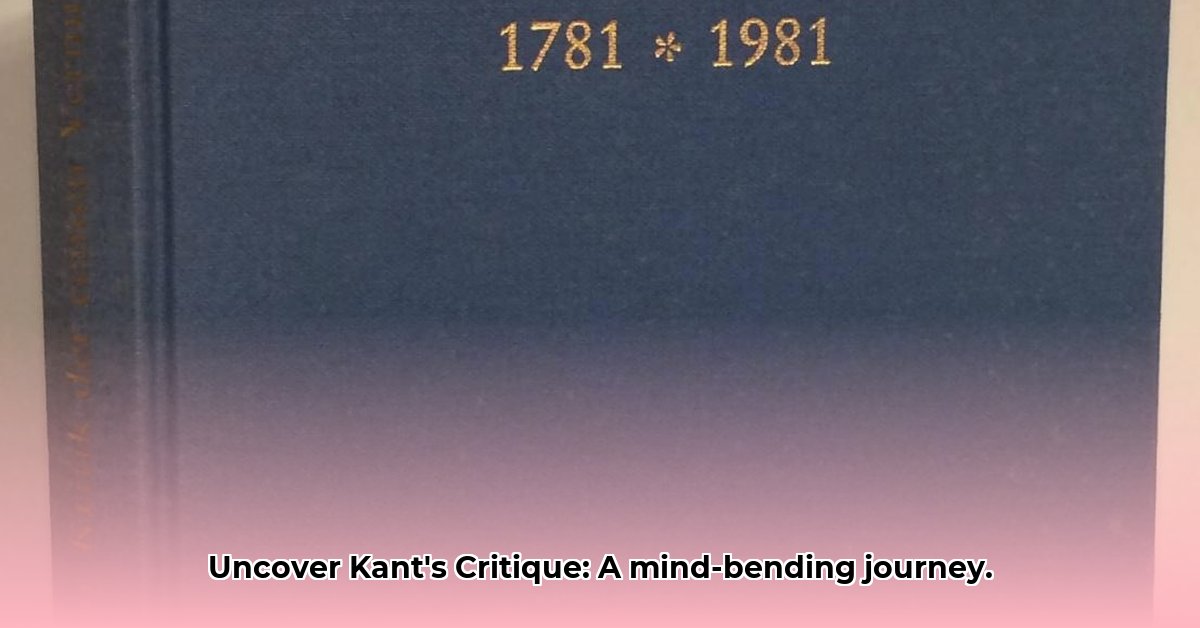
Unpacking Kant's Mind-Bending Masterpiece
Right, so you want to understand Immanuel Kant's Critique of Pure Reason? It’s a famously tricky book, but don't be put off! This work revolutionised philosophy, changing how we think about knowledge and reality. Kant challenged existing ideas, questioning the very foundations of our understanding of the world. His ideas, though written centuries ago, remain incredibly relevant today.
Is it possible to truly know anything? That's the burning question at the heart of Kant's Critique. He didn't simply accept traditional views; he dissected them and attempted to build a more robust philosophical framework. This article will explore key aspects of the Critique, simplifying its complexities to make it accessible.
Knowledge: A Priori vs. A Posteriori – Two Sides of the Same Coin?
Kant cleverly distinguished between a priori and a posteriori knowledge. A priori knowledge is what we know before experience – inherent truths, like "a straight line is the shortest distance between two points." A posteriori knowledge, conversely, is learned through experience, like discovering that fire is hot. But wait, there's more! Kant argued that some knowledge is both a priori and synthetic – it's inherent, yet expands our understanding beyond what we've already experienced.
Did you know? Kant's concept of synthetic a priori knowledge sparked a debate that continues to this day. How can we gain new knowledge without observation?
Synthetic A Priori: The Great Philosophical Debate
This leads us to the core of the Critique: synthetic a priori judgments. This seemingly paradoxical idea suggests that we possess innate knowledge that expands our understanding of the world, without relying solely on direct observation. This is like putting together a jigsaw puzzle where certain pieces seemingly just fit together.
But the question remains: is this universal, or merely subjective? This core concept ignited a firestorm of debate amongst philosophers, and the discussion rages on. Professor Anya Sharma, of Stellenbosch University's Philosophy Department, comments, “Kant’s work is a constant source of debate, the implications of synthetic a priori are still under active discussion”.
Transcendental Idealism: How Our Minds Shape Reality
Kant's transcendental idealism posits that our minds don't passively receive information but actively structure our experience. Our minds aren't blank slates, but rather come equipped with pre-existing 'categories' – mental frameworks—like space, time, and causality—that interpret sensory data. We don't experience raw reality; we experience reality filtered through these mental structures. This isn’t solipsism (the idea that only one's mind is sure to exist), instead it highlights our active role in constructing our understanding of reality. However, what about the "thing-in-itself" – reality independent of our perception? Kant suggests it remains forever unknowable.
Fact: Transcendental idealism offered a unique path between rationalism and empiricism, two previously competing approaches to understanding knowledge.
The Elusive "Thing-in-Itself": The Unknowable Reality
This "thing-in-itself," or noumenon, represents the ultimate mystery—reality as it potentially is, entirely separate from how we perceive it. We only ever experience the phenomena – the world structured by our minds. But the question remains of whether objective reality ultimately exists independently of our mental constructs. This intriguing idea continues to fuel exciting debates amongst philosophers, sparking questions about the nature of reality and the limits of human understanding.
Different Perspectives: A Continuing Conversation
Interpretations of the Critique are diverse. Some focus on Kant's epistemology (the study of knowledge), others on metaphysics (the study of reality), and others on the ethical implications. The continuous re-interpretation keeps the work relevant and under constant critical examination.
Taking the Plunge: Understanding Kant’s Kritik Der Reinen Vernunft
Ready to tackle this philosophical giant? Here’s how:
Choose a clear translation: Modern translators make Kant's work significantly more accessible.
Use secondary sources: Numerous scholars offer helpful insights and analyses.
Break it down: The Critique is huge; approach it piece by piece.
Engage in discussions: Share ideas with others to deepen understanding.
Understand the context: Grasping the historical backdrop is crucial to appreciating Kant's arguments.
By approaching Kant systematically and engaging critically, you will gain a rewarding insight into his pivotal work. It's challenging, yes, but the rewards are immense. The journey is rewarding, even if the destination remains elusive.